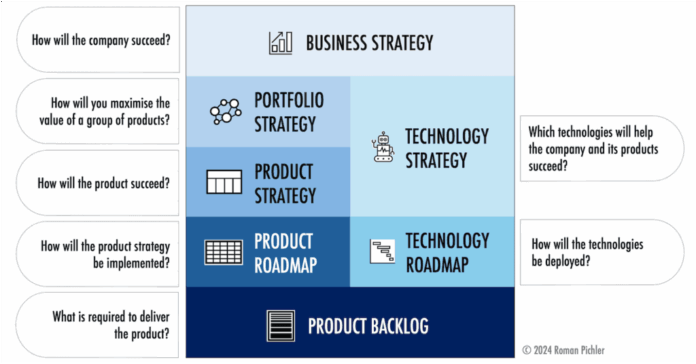Technique and product groups are each key to reaching product success. However what precisely can we imply by technique? Which one is most related for product groups? To what extent ought to the groups form strategic selections? And what function does the top of product play? These are the questions I focus on on this article.
Take heed to the audio model of this text:
What’s Technique?
Technique derives from the traditional Greek phrase strategos, which implies military chief or common. For hundreds of years, the time period was primarily utilized in a navy context to explain how battles have been fought.[1] Immediately, there’s an abundance of methods—consider enterprise, advertising, gross sales, expertise, operations, and, after all, product technique, for instance. Luckily, only some methods are necessary for product groups. These are captured in Determine 1.
The Technique Stack in Determine 1 consists of 5 layers and 7 components. These are the enterprise technique, which can also be known as company technique, the product portfolio technique, the expertise technique, and the product technique, in addition to the product roadmap, the expertise roadmap, and the product backlog. The backlog isn’t a strategic plan, however I’ve added it to the stack to point out how strategic selections could be translated into tactical ones.
Word that I’ve ordered the weather based on their significance, with crucial on the high. As a consequence, higher-level methods information lower-level ones. For instance, the enterprise technique guides the portfolio technique, which directs the product technique. The latter, in flip, drives the product roadmap, which directs the product backlog. This creates alignment and ensures that the choices throughout the totally different layers are constant.[2]
Product Technique and Possession
Out of the 4 methods proven in Determine 1, the product technique is most vital for a product workforce. It describes the strategy chosen to attain product success. To do that, I discover it useful to explain the next 4 components:
- The goal group—the customers and clients who ought to profit from the product.
- The wants—the issue the product ought to assist clear up for the customers and clients, or the profit it ought to supply.
- The enterprise objectives—the advantages the product ought to generate for the corporate that’s growing and offering it.
- The standout options—these features that make it particular and set it aside from competing choices.
In case you are searching for a software to seize the product technique, strive my Product Imaginative and prescient Board, which you’ll obtain totally free along with a helpful guidelines from my web site.
Historically, the product technique is owned by the head of product, the individual in command of the product administration group. Typically, the function can also be referred to as Chief Product Officer and VP or Director of Product Administration, relying on the dimensions and construction of the organisation.
Having a single particular person in command of the technique can supply constant decision-making and shut alignment: Totally different product groups are guided by the top of product’s selections. Nonetheless, this strategy has a number of drawbacks, too, together with the next 4:
- Sluggish selections: The pinnacle of product can turn out to be a bottleneck, particularly when the portfolio grows and extra merchandise are added. Consequently, selections is likely to be delayed, and product groups may not be capable of shortly progress their merchandise.
- Being overworked: The pinnacle of product can turn out to be overworked. As a individuals supervisor, they need to take care of the person product individuals and all the product administration group. Consequently, they’ll expertise stress, decreased productiveness, and, in the long run, well being points.[3]
- Technique-execution chasm: If the product workforce members don’t totally perceive or sufficiently purchase into the product technique, a strategy-execution chasm can open up, and the technique isn’t successfully translated into detailed product selections. The UX and product options could subsequently not align with the technique.
- Lack of in-depth information: The pinnacle of product is likely to be too far faraway from the day-to-day product administration work to completely perceive the influence of strategic product selections. On the identical time, this will make it troublesome to leverage insights from the product discovery and supply work to adapt and evolve the product technique—consider person suggestions you gather on early product increments, for instance. Within the worst case, the flawed strategic selections are taken.
Empowering Product Groups to Make Strategic Choices
If having the top of product in command of product technique isn’t all the time efficient, then what’s the choice? My advice is to empower product groups to personal the methods of their merchandise. Consequently, a product workforce is given the authority to create and evolve the product technique over time. This affords three key advantages:
- Quick decision-making and strategy-execution alignment: The product technique, discovery, and supply work at the moment are carried out by the identical individuals. This hastens the decision-making course of and maximises the possibilities that strategic selections are successfully executed.
- Elevated productiveness: Because the workforce now owns a product in its entirety, the members’ motivation and productiveness are often elevated.
- Worth focus: Taking possession of strategic selections encourages the workforce to deal with person and buyer wants, in addition to enterprise objectives, as an alternative of being primarily involved with product options.
Pretty much as good as this may sound, there are two key challenges with this answer. First, the product workforce could lack the required experience to get the product technique proper. Second, the elevated autonomy could end in misalignment. Within the worst case, totally different product groups create diverging methods and take their merchandise in reverse instructions. Let’s discover how these two challenges could be addressed.
Upskilling Folks and Forming Prolonged Product Groups
A product workforce that consists of a product individual, a developer, and a UX designer is well-equipped to hold out product discovery and supply work. However such a workforce typically lacks the experience to make the fitting strategic product selections. There are two elements at play: First, the product individual doesn’t all the time have the required abilities to methodically develop a successful product technique and an actionable product roadmap. This may be addressed by upskilling the person, for instance, by attending coaching programs, making time for self-study, and being coached by the head of product.
Second, a small product workforce often struggles to make the fitting selections to efficiently monetise their product. It usually lacks the required advertising, gross sales, help, authorized, finance, and operations know-how, relying on the kind of product and the corporate construction. To handle this concern, I like to recommend forming an prolonged product workforce just like the one proven in Determine 3.
The workforce in Determine 3 has key stakeholders as extra members, in addition to a coach. The previous are stakeholders whose experience and help you have to get the product technique proper. They share their experience and contribute to product selections in collaborative workshops, they usually work with the opposite members to progress the product and obtain product success.
For instance, you may focus on the viability of present advertising and gross sales channels in a product workforce assembly. Equally, you may co-create the product roadmap with all product workforce members, as I clarify in additional element within the article Maximising Stakeholder Purchase-in to Product Technique and Product Roadmap.
Because the workforce composition in Determine 3 is heterogeneous and the members could embody senior stakeholders, I like to recommend involving a workforce coach. The function is chargeable for facilitating conferences and serving to the workforce members collaborate successfully. It is likely to be stuffed by an skilled agile coach or Scrum Grasp.[4]
Utilizing a Portfolio Technique to Align the Product Methods and Groups
The second problem when empowering product groups to personal the methods of their merchandise is misalignment. Take Microsoft 365, previously referred to as Workplace, for instance. If PowerPoint, Phrase, and Excel adopted divergent methods, this may not solely end in a fragmented person expertise and inconsistent function units but in addition endanger the suite’s potential to behave as a money cow for Microsoft.
To handle this problem, I like to recommend two measures. First, use a product portfolio technique, which have to be adopted by the person product methods. If we apply this strategy to Microsoft 365, the methods of PowerPoint, Phrase, and Excel should adjust to an total 365 technique, as Determine 4 exhibits.
Second, be certain that the top of product takes care of the product portfolio technique and practices efficient product portfolio administration. This permits the top to align the product methods whereas empowering the product groups to completely personal their merchandise and make all needed technique, discovery, and supply selections: alignment and autonomy are balanced.
Following my recommendation results in the distribution of technique possession proven in Determine 5.
In Determine 5, the enterprise technique is owned by the CEO and the C-suite, the corporate’s executives.[5] The product portfolio technique is created and managed by the top of product along with the portfolio workforce. The product technique, along with the product roadmap and product backlog, is owned by a product supervisor (or Scrum product proprietor) and the product workforce. This ensures that strategic product selections successfully information discovery and supply and that insights from the event work assist evolve the product technique and roadmap. The expertise technique and roadmap, lastly, are owned by the CTO along with senior architects.
If we apply the possession mannequin in Determine 5 to the Microsoft 365 instance, the top of product would maintain the 365 technique along with a portfolio workforce. Separate product groups would personal PowerPoint, Phrase, and Excel and be empowered to find out their methods, so long as they adjust to the general 365 technique.
Notes
[1] Stephen Bungay, 2011, The Artwork of Motion: How Leaders Shut the Gaps between Plans, Actions and Outcomes, p. 23 and Lawrence Freedman, 2017, “The That means Of Technique, Half I: The Origin Story,” Texas Nationwide Safety Overview: Quantity 1, Concern 1.
[2] Whereas I’ve described the connections between the layers top-down, adjustments in a decrease layer can set off variations in a better one. Say that the portfolio technique seems to be flawed, then this will require altering the enterprise technique. To place it in another way, the relations between the layers are bidirectional.
[3] The bigger the product administration group and product portfolio are, the extra seemingly it’s that this may occur.
[4] For extra steerage on forming efficient product groups, seek advice from my article Organising Product Groups for Success.
[5] This doesn’t indicate, nevertheless, that solely the management workforce determines this technique. The other is true: I discover {that a} collaborative strategy like Technique Deployment cannot solely assist create a greater enterprise technique but in addition enhance its acceptance amongst the staff.






